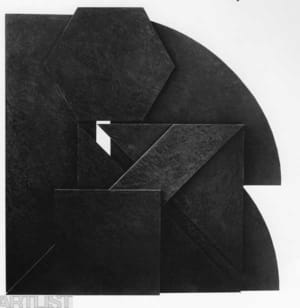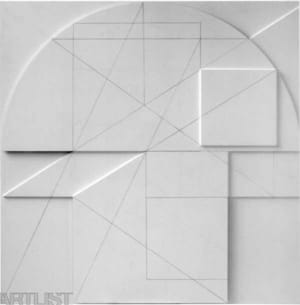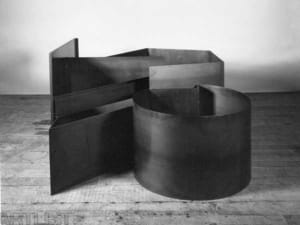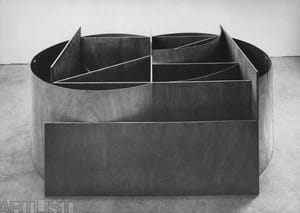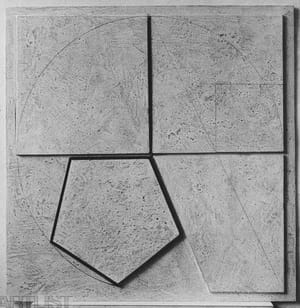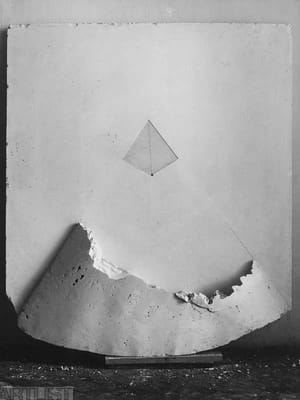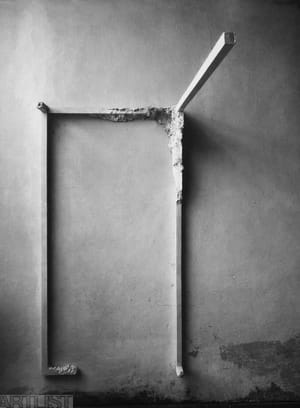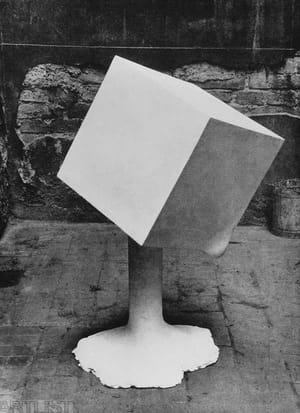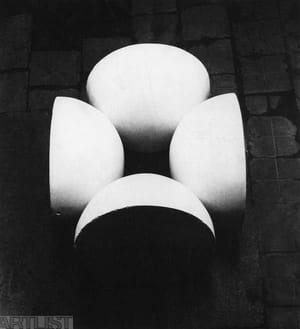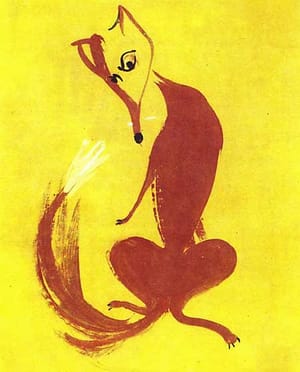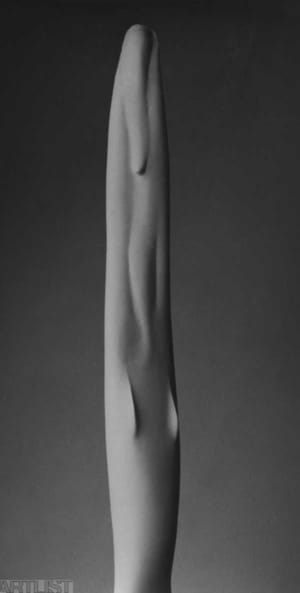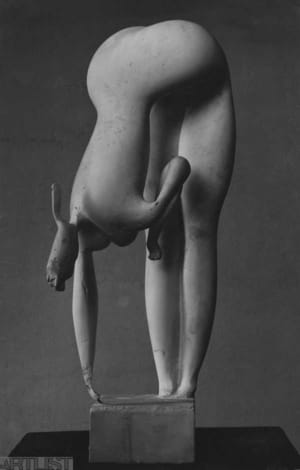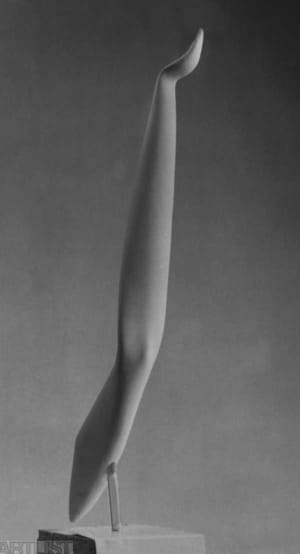- First Name
- Stanislav
- Surname
- Kolíbal
- Born
- 1925
- Birth place
- Orlová
- Place of work
- Prague
- CSU Library
- ↳ Find in the catalogue
About artist
Stanislav Kolíbal is undoubtedly one of the most significant protagonists of Czech, but also international art of the second half of the 20th century with an overlap (thanks to the artist’s respectable age) to the 21st century. Born in Orlová na Těšínsku he moved to Ostrava with his parents following the German occupation of this area. At the end of the war he was engaged in working in the Ostrava mines. It was perhaps these early experiences that injected the existential vertone in his later, otherwise, at first sight quite rationally geometrical work. Kolíbal was inclined to fine arts from an early age. He started modelling and painting when he was thirteen. In 1943 (at the age of 18) he exhibited at a group exhibition in the House of Art in Ostrava. The decision to become an artist was unequivocal, therefore Kolíbal decided to study directly in the centre of action – in Prague.
At that time Kolíbal studied at the Academy of Arts, Architecture and Design in Prague with Professor Strnadel; therefore, he was not directly one of the artists who studied at the sculpting studio of Josef Wagner, which was where the very strong generation of artists (such as V.+V. Janoušek, O. Zoubek, M. Chlupáč, Z. Palcr or E. Kmentová) was constituted. He corresponded with them, however, on the generation level and in searching for ways out of the endlessly imposed dogmatism of the Socialist realism. The work of practically all the mentioned sculptors was inspired by the models of the inter-war avant-garde, but the shapes of their sculptures were summarised, abstracted and stylized to sometimes more geometrical shapes, other times to round curves, all of which excluded the very descriptive realism.
In the 1950s, Kolíbal’s subject was usually the female figure with soft and round shapes. His female bodies are often portrayed in unusual positions: we can find in them Kolíbal’s typical interest in instability and in evoking the feeling of insecurity. His statues of figures and torsos differed from the figural works of his peers at first sight. This artist’s original approach within the scope of the situation back then was ironically thanks to the fact that he didn’t study sculpture: “if I had studied sculpture, I would have never experienced that ever so needed feeling of being unencumbered”, recalls the artist.
Year 1963 was the breaking point: the artist shifts to abstract geometric form. He was able to easily alternate to it not only because he was free of classical sculpting issues such as the building up of mass, but also because he was interested in geometry already in his figural sculptures, demonstrated in the angular position of the arms folded in a sort of diamond shape (Torzo s rukama v bok [Torso with Arms Akimbo], 1959). Since the year 1963 the name Stanislav Kolíbal started to be mentioned in relation to constructive art but Kolíbal did not fully adapt the clean language of construction. Similarly free is his relationship to minimalism, which is often assigned to him. While American minimalism was founded on Frank Stella’s statement “What you see is what you see.”, Kolíbal’s abstract works imply other meanings and messages. Unlike in minimalism that contains strict series’, Kolíbal’s statues are the result of a premeditated composition with a final compositional tension. The topic of instability and unsteadiness becomes an inspiring topic for him. He is constructing his statues and installations from various parts, and a typical Kolíbal composition gives the impression of instability. “Four hemispheres, leaning on one another, kept one another in a peaceful vertical position. They looked very stable but it was just an illusion. They could have fallen apart at any minute”, says Kolíbal about his sculpture Labil from the year 1964. Other times he achieves the feeling of tension by combining organic and inorganic elements (i.e. the statue Symmetrical Object of the Year, 1965). Plaster became the dominating material, which, with its whiteness, takes the expressive effect from his work and directs the viewer rather to a meditative perception. The fragility of this material fully supported the basic idea of Kolíbal’s work, which testifies about the fragility and instability of the human being.
Even in the 1970s instability remained as one of his main elements expressing the feeling of the unpredictability of the human existence. An important moment was his contemplation about time, its changes and duration, and about things that decay and fall apart. Formally, in the 1970s and 80s there is an increase in craftiness in the composition of elements; Kolíbal starts using other materials such as plywood, pieces of sheet metal, sheets of glass, as well as strings and threads with which he replaced the drawn line. In these works Kolíbal toys with optical and sensory illusions – the seemingly “drawn” line has material form.
During the 1970s Kolíbal was not allowed to exhibit. This ironically led him to discover a new artistic form – installation. He concentrated on working in his studio, where he started to put together individual elements into free compositions in relation to the given space: the wall or the floor became a part of the artist’s concept (e.g. Hnědá tabule [Brown Board], 1973; Dvojí možnost [Double Posibility], 1974, and others).
A certain turn in the development of his work comes after 1985 when he enters the scene with relief objects called Geometric Exercises. He has abandoned his former fragile figurativeness. Instead of that the artist started to concentrate on the composition of geometric shapes in a way for a constellation to originate which is harmonic and which presents the viewer with a system. Another breaking point for Kolíbal was the year 1988. Back then he received an invitation from DAAD for a one-year stay in West Berlin. A new world opened up to Kolíbal which was so completely different from the world of a life in totalitarianism. There was the endless freedom on one side, but also the consuming western world full of inexhaustible information that Kolíbal perceived as a world of chaos. This strongly influenced his work. He started working on a series of Constructions – large three-dimensional constructions from wood (later also from iron). In these works Kolíbal expressed his craving for structure which stands against the state of chaos. He wanted to express positive values – something that would not have room for destruction and instability that for years mirrored the state of being in the limited spiritual space of a Communist country.
At the end of the millennium he creates the sculptures Olympia I. and Olympia II. behind which stands the author’s recollection of his visit of ancient Olympia with its collapsed piles of architectonic elements. The principle of instability and principle of a stopped fall has continuation here: a collapse takes place. The statues of the Olympias are black and the elements are organized in a way to evoke the impression of coincidence. Their composition, however, is a well considered conception.
After the year 2000 Kolíbal went back to some of the principles and forms that he already pursued earlier: he produced the cycles called Black Reliefs, White Reliefs and Grey Reliefs. Black Reliefs appear in 1999. Here the artist examines the layering of geometric planes. A series of White Reliefs from 2011 follows where layering is not so apparent but geometric drawing dominates. This series of reliefs develops his Berlin and post-Berlin drawings, which had a continuation soon after 1988 in the three-dimensional objects called Constructions (in which the Berlin drawings were their sort of ground plan predecessor). The second, later path from older drawings led precisely to the White Reliefs, which contain the polarity of spatial drawing and spatial three-dimensionality. The Grey Reliefs from 2012 are the connection of the author’s several experiences: the drawing of the White Reliefs is interconnected with the illusive game with reality known from Kolíbal’s work during the 1970s and 80s.
Practically from the very beginning Kolíbal’s work is accompanied by his interest in geometric arrangement of matter and space. His sculptures and objects are characteristic for applying minimal resources, while having substantial testimonies. Critic Tomáš Pospiszyl gave an apt description of his work when he spoke about Kolíbal as the creator of “emotional geometry”. His work is not actually cold in expression: it is based on the perception of the complementation of contrary values such as stability and instability, order and chaos, duration and frailty, origination and extinction. Kolíbal’s work is the mirror of his personal emotions, evoked by the surrounding world and society. Kolíbal’s work touches the basic transcendent values of the human life. And although this character of art, in the sense of Chalupecký’s emphasis on the transcendent message of an art work, seems to be overlooked by many these days, Kolíbal managed to get admiration even in the lines of many renowned young artists. I think that this is a great satisfaction not only for the artist himself but also for the entire Czech art of the second half of the 20th century.
- Author of the annotation
- Ivona Raimanová
CV
Studies:
2005 State honour of the Czech Republic for services in the field of culture and art
1990-93 Professor at Academy of Fine Arts in Prague
1973-80 prohibited from exporting and selling art works, prohibited from exhibitions
1953 establishes a studio in Prague 7, Nad Královskou oborou 23, and gets married with sculptor Vlasta Prachaticka. Meeting with members of Umělecka beseda.
1951–1954 during his studies Stanislav Kolibal works for theaters in Ostrava, Opava and National Theatre in Prague. After his graduation Stanislav Kolibal becomes consultant and professor of stage technology
1951–1954 studies at the Academy of Performing Arts in Prague, field of scenography, Professor Frantisek Tröstr
1945–1951 studies at the Academy of Arts, Architecture and Design in Prague, Professor Antonin Strnadel
since 1945 begins to work for various newspapers and books. Paints for the newspaper Svet prace, works on illustrations and diptychs. Kolibal would pursue his work on illustrations during the whole life.
1944 was deployed at forced labour in Ostrava mines
1938 after the occupation of the Tesin region by the Polish army, Kolibal moves to Ostrava with his family, where he pursues his studies of at high school, he occasionally produces drawings and moulds.
Residencies:
1968 Pobytové stipendium Karolyiho nadace, Vence, Francie;
1969 Stipendium Fordovy nadace;
1988-89 Pobytové stipendium DAAD Berlin;
1992 Pobytové stipendium Ateliéru Calder, Saché, Le Carroi, Francie.
- Member of art groups included in ARTLIST.
- Member of art groups not included in ARTLIST.
- Nová skupina
Exhibitions
- Solo exhibitions
-
2012
Galerie Zdeněk Sklenář (S), Praha,
Jízdárna Pražského hradu, Praha
2011
Dynamo Design, Praha
White Gallery, Osík u Litomyšle
Brno Gallery, Brno
2010
White Gallery, Osík u Litomyšle
2009
Dům umění, Ostrava
Galerie města Plzně, Plzeň
2008
Galerie Zdeněk Sklenář, Praha
2007
Galerie Woxart, Praha
2006
Walter Storms Galerie, München
2005
Východočeská galerie, Pardubice
Galerie města Bratislavy, Bratislava
Národní galerie, Praha
2004
Moravská galerie (I. část), Brno
Moravská galerie (II. část), Brno
Galerie u Bílého jednorožce, Klatovy
2003
Egon Schiele Art Centrum, Český Krumlov
2002
Dům umění, České Budějovice
2000
Deichtorhallen, Hamburg
1999
Galerie MXM, Praha
Galerie Šternberk, Šternberk
Knoll Galéria, Budapest
Chiese rupestri, Matera
Galerie Sokolská 26, Ostrava
Galerie Václava Špály, Praha
1998
College of Art, Edinburgh
1997
Národní galerie, Praha
1996
Knoll Galéria, Budapest
Nadace Slunce a Luna, Praha
1995
Dům umění, Brno
Galerie moderního umění, Hradec Králové
Galerie umění, Karlovy Vary
Galerie Emila Filly, Ústí nad Labem
1994
Galerie Sokolská 22, Ostrava
Knoll Galerie, Wien
Galerie Ruce, Praha
1993
Musée St. Croix, Poitiers
Galerie MXM, Praha
Muzeum Sztuki, Łódź
Centre d’Art Contemporain, Quimper
Walter Storms Galerie, München
1992
Galerie Jacqueline Moussion, Paris
CCC (Centre de Creation Contemporaine), Tours
Städtische Galerie, Wels
1991
Galerie města Blanska, Blansko
České kulturní středisko, Bratislava
1990
ÚKDŽ, Praha
Knoll Galéria, Budapest
Knoll Galerie, Wien
Sovinec
1989
Galerie DAAD, Berlin
1988
Dům pánů z Kunštátu, Brno
1987
OK Harris Gallery, New York
Kulturní středisko Opatov, Praha
1985
OK Harris Gallery, New York
Letohrádek, Ostrov nad Ohří
1984
Walter Storms Galerie, München
1983
Padiglione d’Arte Contemporanea, Milano
Studio Carlo Grosseti, Milano
1982
OK Harris Gallery, New York
1980
OK Harris Gallery, New York
Henri Gallery, Washington
Činoherní klub, Praha
1977
Altro, Roma
Salone Annunciata, Milano
1976
Marlborough Galleria d’Arte, Roma
1975
Mantra Galleria d’Arte, Torino
Livingstone-Learmonth Gallery, New York
1974
Biblioteka Uniwersytecka, Łódź
1973
Salone Annunciata, Milano
1972
Unimedia Galleria, Genova
1970
Galerie Václava Špály, Praha
1967 Nová síň, Praha
1960
Alšova síň U.B., Praha
1949
Výstavní síň Atom, Pardubice
- Group exhibitions not included in ARTLIST.
-
2012
Josef Hoffmann. Stanislav Kolíbal: Plocha – linie – prostor, Rodný dům Josefa Hoffmanna, Brtnice
2011
Plocha, hloubka, prostor, Moravská galerie, Brno
2010
Kavárna Ostrava, Mánes, Praha
Nová citlivost, National Art Museum of China, Beijing
Painting, Process and Expansion, Museum moderner Kunst Stiftung Ludwig, Wien
Unmistakable Sentences – The Collection Revisited, Ludwig Museum, Budapest
2009
V spektru rozmanitosti 11+1, Galerie hlavního města Prahy, Praha
2008
Genau und anders, Museum moderner Kunst Stiftung Ludwig, Wien
Nechci v kleci!, Muzeum umění, Olomouc
2007
Ohne wenn und aber, Museum moderner Kunst Stiftung Ludwig, Wien
Europe, Russia, Europe, Tretiakovska Galerie, Moskva
Prague Biennale, Karlínská hala, Praha
2006
Raumkunst, Buchberg
Zero (Sammlung Lenz), Museum der Moderne, Salzburg
Transforming Chronologies, MoMA, New York
2005
Entdecken und Besitzen, Museum moderner Kunst Stiftung Ludwig, Wien
2004
Z národní klasiky, Galerie Zdeněk Sklenář, Litomyšl
Šedesátá léta, Dům umění, Brno
Monocromos – de Malevich al presente, Museo Nacional Centro de Arte Reina Sofía, Madrid
2003
Umění je abstrakce, Jízdárna Pražského hradu, Praha
2002
Anima – Animus, Dům umění, Brno
La Culture Pour Vivre, Centre Georges Pompidou, Paris
2001
8. Triennale Kleinplastik, Fellbach
2000
Von E. Degas bis G. Richter, Kunstmuseum, Winterthur
L’autre moitié de l’Europe, Jeu de Paume, Paris
Art in Central Europe 1949-1999, Fundació Joan Miró, Barcelona
1997
Made in France, Centre Georges Pompidou, Paris
1996
Umění zastaveného času, České muzeum výtvarných umění, Praha; Moravská galerie, Brno
1996
Schwerelos Skulpturen, Landesgalerie Linz; Ludwig Muzeum, Budapest
1995
Du trait à la ligne, Centre Georges Pompidou, Paris
1994
Europa-Europa, Kunst und Ausstellunghalle, Bonn
Geometries, Rennes
Der Riss im Raum, Martin-Gropius-Bau, Berlin
1992
Kolekcja Lenz-Schönberg, Zachęta, Warszawa
D’une génération, l’autre, Musée d’Art Moderne de la Ville de Paris, Paris
Reduktivismus, Museum Moderner Kunst, Wien
Das offene Bild, Westfälisches Museum, Münster; Museum der bildenden Künste, Leipzig
1991
Tradition und Avantgarde in Prag, Kunsthalle, Osnabrück
Kunst, Europa, Kunstverein, Braunschweig
1990
Inoffiziel, Museum der Stadt, Regensburg
40 artistes tchéques et slovaques, Musée de Luxembourg, Paris
1989
Sbírka Lenz-Schönberg, Dům umělců, Moskva
1988
Zero, Un Movimiento Europeo, Fundación Juan March, Madrid
1987
50 Years of Collecting, The Solomon R.Guggenheim Museum, New York
1983
8 Künstler aus Prag, Künstlerwerkstätten, München
Two Artists from Prague (+ Adriena Šimotová), Riverside Studios, London
Dessins tchéques du 20e siècle, Centre Georges Pompidou, Paris
1981
Contemporary Painting in Eastern Europe and Japan, National Museum of Art, Osaka
Phoenix, Alte Oper, Frankfurt am Main
Konstrukcja v processie, Łódź
1980
Painting and Sculpture Today, Indianapolis Museum of Art, Indianapolis
11th International Sculpture Conference, Washington
Recent Acquisitions, The Solomon R. Guggenheim Museum, New York
Eleven Contemporary Artists from Prague, New York University; Michigan University, Ann Arbor
1977
The Poetry of Vision, ROCS 77, Dublin
1970
Tsechische Skulptur des 20. Jhds., Schloss Charlottenburg, Berlin
Between Man and Matter, Metropolitan Art Gallery, Tokyo
1969
Arte Contemporanea in Cecoslovachia, Galleria Nazionale d’Arte Moderna, Roma
1968
De Myslbek á nos jours, Musée Rodin, Paris
Nová citlivost, Dům umění, Brno; Galerie umění, Karlovy Vary; Mánes, Praha
1967
Sochařská bilance II, Olomouc
Sculpture from Twenty Nations, The Solomon R. Guggenheim Museum, New York; Art Gallery of Ontario, Toronto; The National
Gallery of Canada, Ottava; Montreal Museum of Fine Arts, Montreal
Mostra d’Arte Contemporanea Cecoslovacca, Promotrice del Belle Arti, Torino
1966
Aktuální tendence (k IX. mezinárodnímu kongresu AICA), Praha
Tschechoslovakische plastik vom 1900 bis zur Gegenwart, Museum Folkwang, Essen
1965
Malarstwo i rzezba z Pragi, Kraków
UB 12, Dům umění, Brno
1964
UB 12, Nová síň, Praha; Dům umění, Zlín
Socha 64, Krajská galerie Liberec
1962
UB 12, Čs. spisovatel, Praha
1958
I. celostátní výstava mladých, Dům umění, Brno
1957
Burant, John, Kolíbal, Prachatická, Šimotová, Alšova síň, Praha
1943
37. členská výstava MSVU, Dům umění, Ostrava
- Collections
-
Museum of Modern Art, New York
Metropolitan Museum of Art, New York
Solomon R. Guggenheim Museum, New York
Brooklyn Museum of Art, New York
Centre Georg es Pompidou, Paříž
FRAC Bretagne
Musée de Grenoble
Musée St. Croix, Poítiers
Tate Gailery, Londýn
Museum Modemer Kunst, Vídeň
Albertina, Vídeň
Peter Ludwig Museum, Budapešť
Museum Sztuki, Lodž
Kunstmuseum Winterthur
Patentamt, Mnichov
Národní galerie, Praha
Galerie hl. města, Praha
České muzeum výtvarných umění, Praha
Moravská galerie, Brno
Galerie Benedikta Rejta, Louny
Alšova jihočeská galerie, Hluboká nad Vltavou
Muzeum umění, Olomouc
Galerie výtvarného umění v Ostravě
Západočeská galerie, Plzeň
Galerie umění, Karlovy Vary
Severočeská galerie výtvarného umění, Litoměřice
Oblastní galerie, Liberec
Galerie moderního umění, Roudnice nad Labem
Galerie moderního umění, Hradec Králové
- Other realisations
Realisations in architecture and public spaces (selection):
1977 Dekorativní zeď ČS. kulturního střediska v Berlíně
1973 Památník 50.výročí ČS. rozhlasu v Praze
1971 Zahrada ČS-zastupitelství, Stokholm
1969 Plastická zeď ČS-zastupitelství, Londýn
1967 Střešní zahrada ČS.pavilonu, EXPO Montreal
1964 Opěrná zeď pankráckého předmostí Nuselského mostu v Praze
Monography
- Monography
2012
Stanislav Kolíbal, Sochy a projekty/Sculptures and Projects, Arbor Vitae, Praha
2009
Kresby ke knihám : 1947-1994, Ostrava / 1943 -1949, Arbor Vitae, Praha
2003
Stanislav Kolíbal, Kresby, sochy, komentáře, Egon Schiele Art Centrum, Český Krumlov,
2005
Stanislav Kolíbal, Šest cyklů / Six Cycles, Kresby, akvarely, reliéfy / Drawings Watercolour Reliefs, Arbor Vitae
2000
Stanislav Kolíbal : Labil, stabil : Plastiken und Zeichnungen, Hamburg : Deichtorhallen
1999
Stanislav Kolíbal : Opere dal 1956 al 1999, Roma : Edizioni della Cometa
1997
Stanislav Kolíbal, Retrospektiva, Národní galerie v Praze
1995
Stanislav Kolíbal 1988 – 1995, Dům umění města Brna
1989
Stanislav Kolíbal : Daadgalerie, Berlin 30, Berliner Künstlerprogramm des DAAD
- Other critical texts
Other sources:
2010
Klimešová Marie , Roky ve dnech (České umění 1945 - 1957), Galerie hlavního města Prahy, Praha
Stanislav Kolíbal: Bílé kresby / White Drawings 1968-1976, White Gallery, Osík
Stanislav Kolíbal: Kresby v ploše a v prostoru / Drawings in Plane and Space, Galerie města Plzně
2009
Stanislav Kolíbal: Kresby ke knihám 1947-1994, Arbor Vitae, Praha
Beneš Ondřej , Ševčík Oldřich , Architektura 60. let („Zlatá šedesátá léta“ v české architektuře 20. století), Grada Publishing, a.s., Praha - Holešovice
2007
Hlaváček Josef , Cvičení z estetiky, Gallery, spol. s r.o. (Jaroslav Kořán), Praha
Stanislav Kolíbal, Galerie Woxart
2005
České ateliéry / Czech studios (71 umělců současnosti / 71 contemporary artists ), Art CZ, Praha
2004
Stanislav Kolíbal: Prostor rozhodování, Moravská glerie, Brno
2003
Umění je abstrakce: česká vizuální kultura 60. let, Kant ; Arbor vitae, Praha
2003
Petr Volf, Na začátku je čára : rozhovory s výtvarníky, Paseka, Praha, Litomyšl
2002
Osobnosti českého grafického designu (Stanislav Kolíbal), Muzeum umění Benešov
2001
Hůla Jiří , Rozhovory, Nakladatelství Dauphin, Praha
2000
Stanislav Kolíbal: Labil - Stabil
1999
Hlaváček Josef , Umění je to, co dělá život zajímavější než umění (jak praví r.f.), Artefact, Praha
Stanislav Kolíbal - Kresba – prostor, Galerii Šternberk
Stanislav Kolíbal, Centrum kultury a vzdělávání , Výstavní síň Sokolská 26, Ostrava
1997
Machalický Jiří , Česká grafika XX. století ve Sdružení českých umělců grafiků HOLLAR, Sdružení českých umělců grafiků Hollar, Praha
J.Valoch - S.Kolíbal / Retrospektiva, NG v Praze
1996
Jiří Šetlík, Cesty po ateliérech: 1976-1986, Torst, Praha
1995
Olič Jiří , Pomocný slovník českých a slovenských výtvarných umělců, F. R. & G. spol. s r.o., Bratislava (Bratislava)
Stanislav Kolíbal /1988-1995, Dům umění města Brna
Stanislav Kolíbal (Česká kresba 3), Galerie umění Karlovy Vary
Stanislav Kolíbal: Texty. Tři originální kresby Stanislav Kolíbal. Aulos, Praha. Vydáno 40 číslovaných výtisků ve formátu 350 x 253 mm
1994
Chalupecký Jindřich , Nové umění v Čechách, Nakladatelství a vydavatelství H&H, s.r.o., Jinočany (Praha-západ)
Ohniska znovuzrození: České umění 1956-1963, Galerie hlavního města Prahy, Ústav dějin umění AV ČR, Praha
Galerie MXM 1992-1993, Galerie MXM, Praha
1993
Stanislav Kolíbal: Konstrukcje – Constructions, Muzeum Sztuki , Lodž
Pět osobností : Václav Boštík, Čestmír Kafka, Stanislav Kolíbal, Karel Malich, Adriena Šimotová a jejich díla ze sbírek Galerie Benedikta Rejta, Galerie Benedikta Rejta, Louny
Jiří Šefčík, Situation Prag : Dialog zweiter Generationen, Kampnagel-Internationale Kulturfabrik, Hamburk
1992
Stanislav Kolibal, Atelier Calder, Orléans
1991
Détente, Museum Moderner Kunst Stiftung Ludwig, Vídeň
Hlaváček Josef , Výpovědi umění, Severočeské nakladatelství, Ústí nad Labem (Ústí nad Labem)
J.Ševčíková-J.Ševčík / Kunst, Evropa AdKV, Verlag Herman Smidt, Mainz
1990
Umělecké sdružení Nová skupina, Národní galerie v Praze
1989
Zhoř Igor , Klíče k sochám (Čtení o sochách a sochařích), Albatros, nakladatelství pro děti a mládež, Praha
Stanislav Kolíbal: Kresby '88, Ústřední kulturní dům železničářů, Praha
1988
Stanislav Kolíbal: Knihy, kresby, prostor, Dům umění města Brna
1987
Stanislav Kolíbal, Opatov 1987, KS Opatov
1985
Stanislav Kolíbal : Kresby a ilustrace, Galerie umění, Karlovy Vary
1983
Stanislav Kolíbal, Padiglione d'Arte Contemporanea, Milán
8 Künstler aus Prag in München, Kulturreferat der Landeshauptstadt München a Institut für moderne Kunst, Norimberk
1981
Eleven contemporary artists from Prague, Michigan University
1980
Konečný Dušan , Umění a doba, Odeon, nakladatelství krásné literatury a umění, n.p., Praha
Stanislav Kolíbal: Mezi prostorem a plochou (Siítuace 6), Jazzová sekce Svazu hudebníků, Praha
1979
Bénamou Geneviève , L´art aujourd´hui en Tchecoslovaquie, Geneviève Bénamou, Paříž (Paris)
1976
Stanislav Kolíbal, Marlborough Galleria d´arte, Řím 1976
1974
Hilton Kramer / The Age of the Avant Garde, Secket and Warburg, London
1973
Devět kreseb z let 1968-1972, Jiří, MPVU, Brno
Stanislav Kolíbal, Salone Annunciata Milano
1968
Nová citlivost : Křižovatka a hosté, Dům umění Brno
1967
Stanislav Kolíbal, Svaz československých výtvarných umělců, Praha
1960
Stanislav Kolíbal, Umělecká beseda, Praha
1957
Vlasta Prachatická Adriena Šimotová Jiří John František Burant Stanislav Kolíbal, Umělecká beseda, Praha
Catalogues, publications:
S.K. Šest cyklů, Arbor Vitae, Praha 2004
S.K. Kresby, sochy, komentáře, E. Schiele Art Centrum, Český Krumlov 2003
S.K. Texten, Deichtorhallen, Hamburg 2000
S.K. Labil-Stabil, texty Felix, Zdeněk; Smolik, Noemi, Deichtorhallen, Hamburg 2000
S.K. Opere dal 1956 al 1999, texty Appella, G.; Dorfles, Gillo; Perilli, Achille; Gualdoni, f., Edizioni della Cometa, Roma 1999
Stanislav Kolíbal. Retrospektiva, texty Rousová, Hana; Dorfles, Gillo; Valoch, Jiří; Erben, Václav; Chalupecký, Jindřich; Lamač, Miroslav; Zemina, Josef; Messe, Thomas M.; Gruen, John; Hlaváček, Josef; Felix, Zdeněk; Perilli, Achille; Ševčík, Jiří, Nárdoní galerie, Praha 1997
Česká kresba 3, text Valoch, Jiří, Galerie umění, Karlovy Vary 1995
S.K. 1988-1995, text Valoch, Jiří, DUMB, Brno 1995
S.K. Texty, Aulos, Praha 1995
S.K., text Elkar, Catherine, Le Quartier, Quimper 1993
Du spirituel au conceptuel, text Villeneuve, Jeanne, Musée St-Croix, Poitiers 1993
S.K. - Konstrukcje, texty Jedlinski, J.; Zagula, A., Muzeum sztuki, Lodź 1993
S.K., texty Valoch, Jiří; Nuridsany, Michel, Atelier Calder 1992
S.K. - Kresby, text Janoušek, Ivo, ÚKDŽ, Praha 1989
S.K., text Felix, Zdeněk, Galerie DAAD, Berlín 1989
S.K. - Knihy, kresby, prostor, text Valoch, Jiří, DUMB, Brno 1988
Kresby, text Rousová, Hana, Galerie umění, Karlovy Vary 1985
S.K., vlatní text, Padiglione d´arte contemporanea, Milano 1983
S.K., O.K.Harris Gallery, New York 1980
Srp, Karel, S.K. - mezi prostorem a plochou, Situace 6, Jazzová sekce, Praha 1980
S.K., text Perilli, Achille, Marlborough Galleria d´arte, Řím 1976
Devět kreseb z let 1968-1972, text Valoch, Jiří, MPVU, Brno
1973
S.K., texty Zemina, Josef; Messer, Thomas M., Washington 1973
S.K., vlastní text, Nová s´ˇn, Praha 1967
